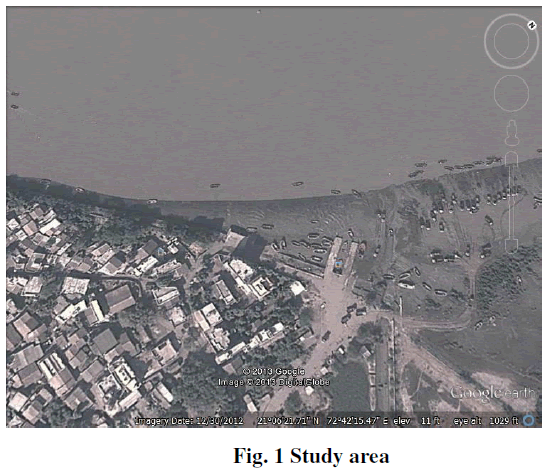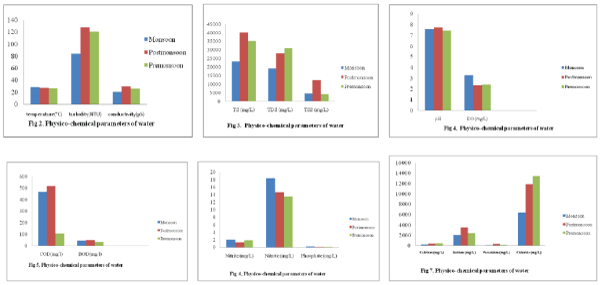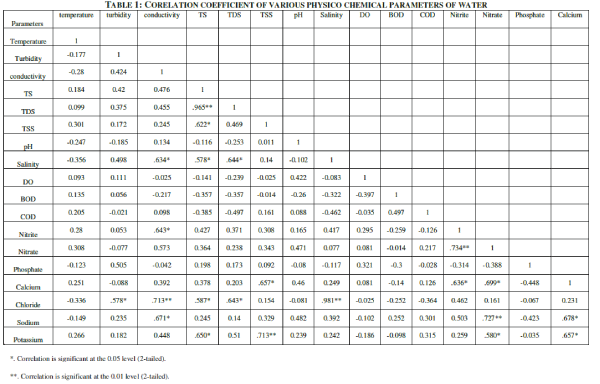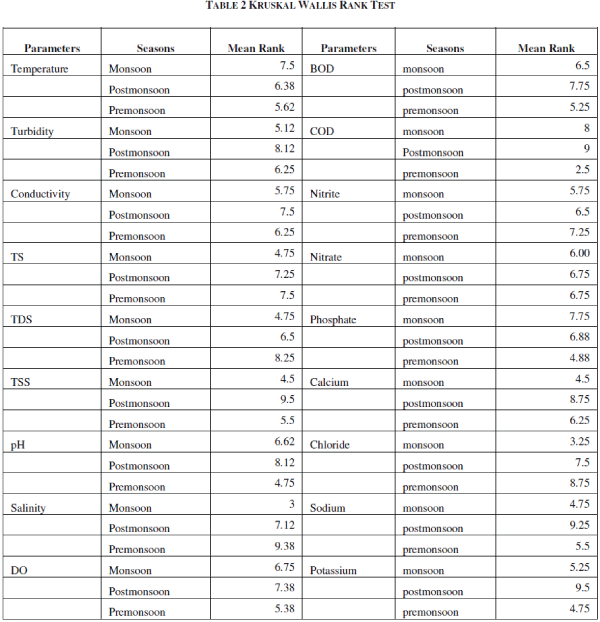ISSN ONLINE(2319-8753)PRINT(2347-6710)
ISSN ONLINE(2319-8753)PRINT(2347-6710)
Surana Ranjana1, Gadhia Mohini2 and Ansari Ekhalak2
|
| Related article at Pubmed, Scholar Google |
Visit for more related articles at International Journal of Innovative Research in Science, Engineering and Technology
The rapid industrialization and anthropogenic activities along the estuarine system and the coastal areas have brought considerable decline in the water quality of the estuaries. Uncontrolled discharges of domestic wastes and industrial effluents have affected the Tapi estuary. Present study was carried out from June 2011 to May 2012 to determine the important physic-chemical parameters of water of Tapi estuary at Dumas jetty. Turbidity, conductivity, total solid, total dissolved solid, salinity, pH, dissolved oxygen, BOD, COD, calcium, chloride, sodium , potassium and nutrients like nitrate, nitrite and phosphate were studied. Correlation coefficient was carried out between various physic-chemical parameters. Significant correlation was found for salinity, TS, TDS, sodium and chloride .High BOD and COD was recorded exhibiting positive correlation. Kruskal wallis test showed that physic-chemical parameters varied seasonally. The study showed that the water quality of Tapi estuary at Dumas jetty was affected by industrial as well as anthropogenic activities.
Keywords |
| Physico-chemical parameters, Nutrients, seasonal variation, Correlation- coefficient |
INTRODUCTION |
| Estuary is a semi-enclosed coastal body of water which has a free connection with the open sea and with fresh water from land drainage. Estuaries are dynamic, highly productive ecosystems [1]. Estuarine processes vary in a systematic manner within tidal cycle (semidiurnal, diurnal), weather cycles (seasonal and inter annual cycles) [2]. The structure and functions of estuaries are controlled by internal processes as well as by adjacent land and sea. The rapid industrialization and anthropogenic activities along the estuarine system and the coastal areas have brought considerable decline in the water quality of the estuaries. Immense pressure of population, industrialization in adjacent areas and on the river banks which joins the system and rapid urbanization are the threats faced by estuaries Regular study of estuaries are important as these regions are ecologically rich and most productive . Coastal zones and estuaries are important ecological systems and resources for variety of uses. The total life on the earth depends on water for different purposes. The environmental conditions such as topography, water movement and stratification, salinity, oxygen, temperature and various nutrients characterizing particular water mass determine the composition of its biota. Several reports are available on the physico-chemical features of Indian estuaries [3, 4, 5, 6, 7, 8, 9, 10 and 11]. The current study was undertaken to assess the present status of water quality in Dumas jetty with reference to physicchemical characteristics of water. |
| The Tapi estuary is permanent tropical estuary and one of the major estuaries on the Gulf of Khambhat .The estuary is located at geographical position latitude 21°40’N and Longitude 72° 40’E. Its length from source to mouth is about 720 km and with a catchment area of approximately 1,650,000 km2. Dumas jetty was selected which is the mouth of the estuary in the southern bank. It is 16 Km away from main city Surat (Fig. 1). |
 |
| It receives industrial effluents released from urban city like Surat and many chemical and fertilizers industries in and around Hazira industrial area forming the major source of pollution in to the estuary. |
MATERIALS AND METHODS |
| Water samples for the analyses of physical and chemical parameters were collected from the river at monthly interval from June 2011 to May 2012 during low tide, in polyethylene bottles and brought to the laboratory. Water parameters analyzed were temperature, turbidity, conductivity, total solid, total dissolved solid, salinity, pH, dissolved oxygen, BOD, COD, calcium, chloride, potassium and nutrients like nitrite, nitrate and phosphate. Preservation and analysis were done following standard methods of [12] and [13]. |
| Statistical analyses were employed to interpret the results using software SPSS 16. Correlation coefficient (r) described the strength of relationship between two inter dependent variables. The normality of data was tested and the data were not distributed normally, non parametric test Kruskall wallis was performed. |
RESULTS AND DISCUSSION |
| The analytical mean results of physio-chemical parameters of water samples are summarized in Fig. 2-7. |
 |
| Correlation-coefficient derived for various physico- chemical parameters is shown in Table 1. |
 |
| Result of Kruskal Wallis test is depicted in Table-2. |
 |
| Surface water temperature fluctuated from 22°C to 32.8°C (Fig.2). Turbidity of the water varied from 22 to 240NTU.Minimum turbidity was registered during monsoon season and the maximum was recorded in Post monsoon (Fig.2). Conductivity was recorded minimum (0.663mS) in monsoon and maximum (42.31mS) in post monsoon (Fig.2). Total solid and total dissolved solid values were found minimum in monsoon and maximum in post monsoon season (Fig.3). pH varied from 7.1 to 8.2 respectively (Fig.4) Salinity of the water varied from 0.28 to 32.00 ppt in monsoon and pre-monsoon respectively (Fig.4). Dissolved oxygen was recorded maximum 5.47mg/l and minimum 0.41mg/l (Fig.4). BOD values varied from 8.11 to 81.00 mg/l and COD from 48 to 928 mg/l (Fig.5). Nitrite was recorded minimum (0.25mg/l) in post monsoon and maximum (5.57mg/l) in monsoon (Fig.6). Nitrate value ranged from 1.93 to 46.06mg/l in different seasons (Fig.6). Phosphate was found minimum in pre monsoon and maximum in monsoon season (Fig.6). Calcium and Chloride were found maximum in pre-monsoon (Fig.7). Sodium and potassium concentrations were found maximum in post monsoon season (Fig.7). |
| The mean seasonal water temperature recorded was not fluctuating much round the year. Variation in temperature was due to the meteorological characteristics. Turbidity is affected by sunshine, clear water conditions and removal of suspended materials from the water column and cessation of freshwater flow. Turbidity exhibited positive correlation with dissolved oxygen, nutrients and negative correlation with pH and COD. Higher value of conductivity recorded in post monsoon is attributed to low mixing of fresh water input from river causing more ionic concentration and lower value in monsoon is due to rain and mixing of more fresh water from river. The maximum salinity during pre-monsoon season was due to the high degree of evaporation of surface water and the domination of adjacent neritic waters and low wave and tidal action with decreased freshwater inflow and land drainage. Similar observations were also made in Mahanadi estuary [14]. The minimum salinity was due to the monsoonal rain, flooding and freshwater input into the study areas. Salinity showed positive significant correlation with conductivity, total solid and total dissolved solid. |
| The pH value did not show fluctuation during the study (Fig.4). pH remained alkaline throughout the study period indicating that the estuarine water having high buffering capacity resulting limited change of pH values in channel of Cauvery river [15]. |
| Higher Dissolved oxygen during the monsoon season was due to the monsoonal floods, turbulence of water caused by the freshwater mixing with the seawater [16]. The study also agrees with the other [17 and 11]. The low dissolved oxygen concentration in dry season could be attributed to the lesser input of freshwater into the study area. The study is supported by various scholars [18 and 19]. The dissolved oxygen concentration showed negative correlation with BOD and COD. Higher value of BOD recorded during the post-monsoon season could be due to the microbial utilization of oxygen and occasional freshwater input and low BOD in the pre monsoon season due to effective assimilation of organic load [20]. Maximum COD during the post-monsoon season was due to decrease in freshwater inflow, land drainage, domestic sewage and industrial inputs increase in salinity, temperature and phytoplankton productivity and microbial utilization of oxygen at the time of decomposition [21]. Low COD observed during the pre-monsoon season may be due to the presence of heavy river run-off, decreased mixing of agricultural and domestic wastes, land drainage into the estuary and decreased biological activity due to decreased salinity and temperature. In the present study BOD and COD showed negative correlation with salinity, calcium and dissolved oxygen and positive correlation with temperature. |
| In the present investigation, inorganic phosphate recorded high during the monsoon season and there was a decrease in the concentration during the post monsoon season. This might have been due to rainfall, addition of domestic sewage and fertilizers from the adjacent agricultural land. High concentration of nitrate observed during the monsoon season might be due to the heavy rainfall, resultant river run-off, land drainage and input of fertilizers from the adjacent agricultural fields and oxidation of ammonia [22]. Most of the nitrate might have been derived from the decomposition of organic wastes [23]. The peak value of nitrite during the monsoon season may be attributed to the influence of seasonal flood as has been observed in the case of phosphate and nitrate [24]. Excretion of phytoplankton, reduction of nitrate and oxidation of ammonia may all contribute together or individually for an increase in the concentration of nitrite in this environment [25]. |
| Low values of nitrite observed during the post-monsoon season are in agreement with the present [26]. This might be due to the lesser amount of freshwater inflow and higher salinity. In coastal waters comprising near shore, the concentration of calcium varies with the factors such as land drainage, precipitation and dissolution. The high concentrations of calcium can be attributed to their release from the exchangeable sites of majority of riverine clays with other cations in the early stages of estuarine mixing. Calcium showed positive significant correlation with TS, TDS, Nitrite and Nitrate. The high chloride concentration in water indicates the presence of large amount of organic matter. The higher concentration of chloride in water is an index of pollution of animal origin and there is a direct correlation between chloride concentration and pollution levels. The possible reason for lower concentration of chloride in monsoon may be due to the lesser input from the industrial activity while, higher concentration of it may be due to seawater intrusion coupled with huge influx of sewage and industrial wastewater. Chloride showed significant positive correlation with salinity, turbidity, conductivity, TS and TDS. |
| Kruskal Wallis Rank test showed seasonal variation in physico chemical characteristics that was found affected due to industrial as well as anthropogenic activities. The recorded physico-chemical characteristics of the estuary water exceeded the tolerance limits for the survival and growth of aquatic organisms as prescribed by Coastal cater quality standard. The polluted nature is shown by much higher levels of BOD, COD, very low dissolved oxygen which are also taken as pollution indicating parameters. It can be concluded that Dumas is getting polluted due to industrial and anthropogenic activities. The result of study showed that the present status of pollution at Tapi estuary in Dumas jetty was due to the organic pollution, the major causes were industrial discharges, domestic sewage from Surat city along with other natural and anthropogenic sources. The regular monitoring of water parameters should be done and steps should be taken up in the study area to minimize further pollution in coming future. |
ACKNOWLEDGEMENT |
| The author (R. Surana) is thankful to UGC for providing Junior Research Fellowship. The authors gratefully acknowledge Dr. A.G. Thivakaran, Senior Scientist, Gujarat institute of Desert Ecology for his immense help and valuable suggestions in carrying out the research. |
References |
|